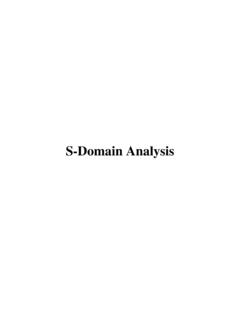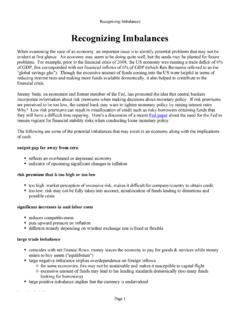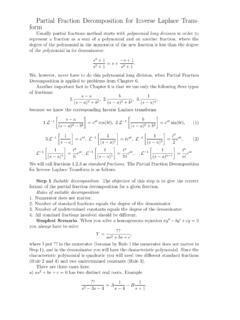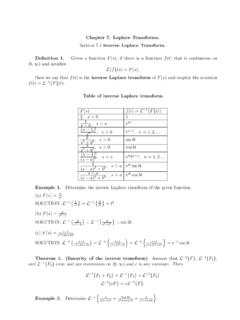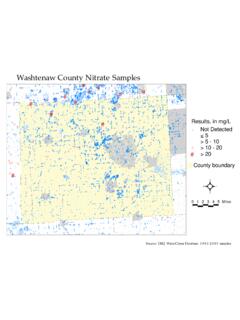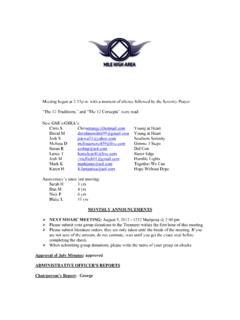Transcription of s-Domain Circuit Analysis
1 MAE140 Linear Circuits132s- domain Circuit AnalysisOperate directly in the s- domain with capacitors,inductors and resistorsKey feature linearity is preservedCcts described by ODEs and their ICsOrder equals number of C plus number of LElement-by-element and source transformationNodal or mesh Analysis for s- domain cct variablesSolution via Inverse Laplace TransformWhy?Easier than ODEsEasier to perform engineering designFrequency response ideas - filteringMAE140 Linear Circuits133 Element TransformationsVoltage sourceTime domainv(t) =vS(t)i(t) = depends on cctTransform domainV(s) =VS(s)=L(vS(t))I(s) = L(i(t)) depends on cctCurrent sourceI(s) =L(iS(t))V(s) = L(v(t)) depends on cct+_i(t)vSiSv(t)MAE140 Linear Circuits134 Element Transformations contdControlled sourcesShort cct, open cct, OpAmp relationsSources and active devices behave identicallyConstraints expressed between transformed variablesThis all hinges on uniqueness of Laplace Transforms andlinearity)()()()()()()()()()()()()()( )()(2121212121212121sgVsItgvtisrIsVtritv sIsItitisVsVtvtv=!
2 ==!==!==!="" )()()()(0)(0)(0)(0)(sVsVtvtvsItisVtvPNPN OCOCSCSC=!==!==!=MAE140 Linear Circuits135 Element Transformations contdResistorsCapacitorsInductors)()()() ()()()()(sGVsIsRIsVtGvtitRitvRRRRRRRR=== =iRvRsisVsLsILissLIsVidvLtidttdiLtvLLLLL LtLLLLL)0()(1)()0()()()0()(1)()()(0+=!=+ =="##RsYRsZRR1)()(==sCsYsCsZCC==)(1)(sLs YsLsZLL1)()(==vCiCvLiL+++svsIsCsVCvssCVs IvdiCtvdttdvCtiCCCCCCCtCCCC)0()(1)()0()( )()0()(1)()()(0+=!!=+=="##MAE140 Linear Circuits136 Element Transformations contdResistorCapacitorNote the source transformation rules apply!IR(s)VR(s)+-vR(t)+-vC(t)+-iR(t)iC( t)RRCsC1)0(CCvVC(s)+-IC(s)VC(s)+-IC(s)+_ svC)0(sC1)()(sRIsVRR=svsIsCsVCvssCVsICCC CCC)0()(1)()0()()(+= =MAE140 Linear Circuits137 Element Transformations contdInductorssisVsLsILissLIsVLLLLLL)0() (1)()0()()(+= =iL(t)+_vL(t)-+sLLiL(0)IL(s)+VL(s)-IL(s) VL(s)+-sLsiL)0(MAE140 Linear Circuits138 Example 10-1 T&R p 456RC cct behaviorSwitch in place since t=- , closed at t=0. Solve for vC(t).Initial conditionss- domain solution using nodal analysist- domain solution via inverse Laplace transformRVAt=0 CRsC1)0(CCvI2(s)I1(s)vC+-)(1)()()()(21ss CVsCsVsIRsVsICCC===ACVv=)0()()(1)(tueVtv RCsVsVRCtAcAC!
3 =+=MAE140 Linear Circuits139 Example 10-2 T&R p 457 Solve for i(t)KVL around loopSolveInvert+_RVAu(t)Li(t)+_+_RsLI(s) sVALiL(0))(sVL+-0)0()()(=++!LALisIsLRsV! i(t)=VAR"VARe"RtL+iL(0)e"RtL# $ % & ' ( u(t)Amps! I(s)=VALss+RL()+iL(0)s+RL=VARs+iL(0)"VAR # $ % & ' ( s+RLMAE140 Linear Circuits140 Impedance and AdmittanceImpedance is the s- domain proportionality factorrelating the transform of the voltage across a two-terminal element to the transform of the currentthrough the element with all initial conditions zeroAdmittance is the s- domain proportionality factorrelating the transform of the current through atwo-terminal element to the transform of thevoltage across the element with initial conditionszeroImpedance is like resistanceAdmittance is like conductanceMAE140 Linear Circuits141 Circuit Analysis in s-DomainBasic rulesThe equivalent impedance Zeq(s) of two impedances Z1(s)and Z2(s) in series isSame current flowsThe equivalent admittance Yeq(s) of two admittances Y1(s)and Y2(s) in parallel isSame voltage)()()(21sZsZsZeq+=I(s)V(s)Z2Z1+-( )()sIsZsIsZsIsZsVeq)()()()()(21=+=)()()( 21sYsYsYeq+=I(s)V(s)Y1+-Y2)()()()()()())
4 (21sVsYsVsYsVsYsIeq=+=MAE140 Linear Circuits142 Example 10-3 T&R p 461 Find ZAB(s) and then find V2(s) by voltage division+_Lv1(t)RCABv2(t)+-+_sLV1(s)RABV 2(s)+-sC1 +++=++=+=1111)(2 RCsRLsRLCssCRsLsCRsLsZeq)()()()()(12112s VRsLRLCsRsVsZsZsVeq!"#$%&++=!!"#$$%&=MAE 140 Linear Circuits143 Superposition in s- domain cctsThe s- domain response of a cct can be found as thesum of two zero-input response caused by initial conditionsources with all external inputs turned zero-state response caused by the external sourceswith initial condition sources set to zeroLinearity and superpositionAnother subdivision of response the general solutionResponse representing the natural modes (poles) of response the particular solutionResponse containing modes due to the inputMAE140 Linear Circuits144 Example 10-6 T&R p 466 The switch has been open for a long time and is closedat t= the zero-state and zero-input components of V2(s)Find v(t) for IA=1mA, L=2H, R= , C=1/6 FIAv(t)t=0 RCL+-V(s)RsL+-sIAsC1 RCIARLsRLCsRLssCRsLsZeq++=++=2111)(LCsRC ssRIRCIsZsVLCsRCsCIsIsZsVAAeqziAAeqzs11) ()(11)()(22++==++==MAE140 Linear Circuits145 Example 10-6 contdSubstitute valuesLCsRCssRIRCIsZsVLCsRCsCIsIsZsVAAeq ziAAeqzs11)()
5 (11)()(22++==++==! Vzs(s)=6000(s+1000)(s+3000)=3s+1000+"3s+ 3000vzs(t)=3e"1000t"3e"3000t[]u(t)! Vzi(s)= (s+1000)(s+3000)=" +1000+ +3000vzi(t)=" "1000t+ "3000t[]u(t)V(s)RsL+-sIAsC1 RCIAMAE140 Linear Circuits146 Example 10-11 T&R (not in 4th ed)Formulate node voltage equations in s- domain +_R1v1(t)+-R2C2C1R3vx(t)+- vx(t)v2(t)+-+_R1V1(s)+-R2C2vC2(0)R3Vx(s) +- Vx(s)V2(s)+-11sCC1vC1(0)21sCABCDMAE140 Linear Circuits147 Example 10-11 contdNode A: Node D:Node B:Node C:+_R1V1(s)+-R2C2vC2(0)R3Vx(s)+- Vx(s)V2(s)+-11sCC1vC1(0)21sCABCD! VB(s)"VA(s)R1+VB(s)"VD(s)R2+VB(s)1sC1+VB (s)"VC(s)1sC2"C1vC1(0)"C2vC2(0)=0)()(1sV sVA=)()()(sVsVsVCxD ==! "sC2VB(s)+sC2+G3[]VC(s)="C2vC2(0)MAE140 Linear Circuits148 Example 10-16 T&R (not in 4th ed)Find vO(t) when vS(t) is a unit step u(t) and vC(0)=0 Convert to s- domain +_R1vS(t)+-CR2vO(t)+ABCD+_R1VS(s )+-R2VO(s)+sC1 CvC(0)VA(s)VB(s)VC(s)VD(s)MAE140 Linear Circuits149 Example 10-16 contdNodal AnalysisNode A:Node D:Node C:Node B:Node C KCL:Solve for VO(s) Invert LT+_R1VS(s)+-R2VO(s)+sC1 CvC(0)VA(s)VB(s)VC(s)VD(s))()(sVsVSA=)() (sVsVOD=)0()()()(11 CSBCvsVGsVsCG=!)
6 +0)(=sVC)0()()(2 COBCvsVGssCV!=!!CRsRRsCRssRRsVCRssRRsVsC GGCsGsVSSO1211211211211111)(1)()(+!"=##$ %&&'(+!"=##$%&&'(+!"=###$%&&&'(+"=)()(12 1tueRRtvCRtO =MAE140 Linear Circuits150 Features of s- domain cct analysisThe response transform of a finite-dimensional,lumped-parameter linear cct with input being asum of exponentials is a rational function and itsinverse Laplace Transform is a sum of exponentialsThe exponential modes are given by the poles of theresponse transformBecause the response is real, the poles are eitherreal or occur in complex conjugate pairsThe natural modes are the zeros of the cctdeterminant and lead to the natural responseThe forced poles are the poles of the input transformand lead to the forced responseMAE140 Linear Circuits151 Features of s- domain cct analysisA cct is stable if all of its poles are located in theopen left half of the complex s-planeA key property of a systemStability: the natural response dies away as t Bounded inputs yield bounded outputsA cct composed of Rs, Cs and Ls will be at worstmarginally stableWith Rs in the right place it will be stableZ(s) and Y(s) both have no poles in Re(s)>0 Impedances/admittances of RLC ccts are PositiveReal or energy dissipating)))

